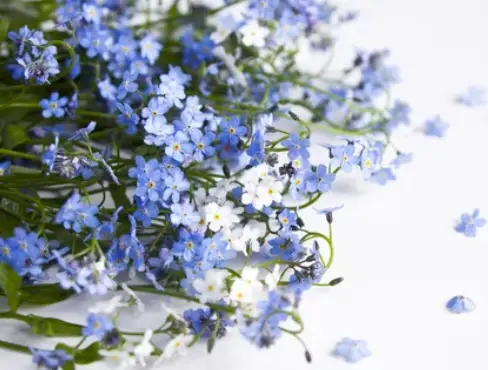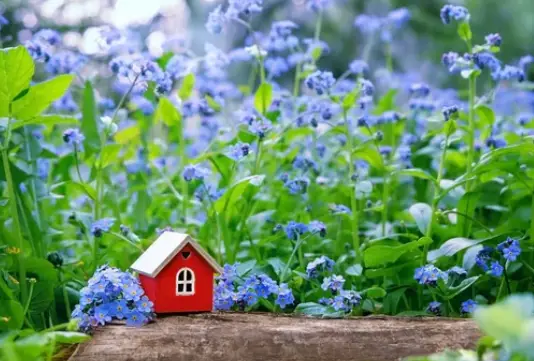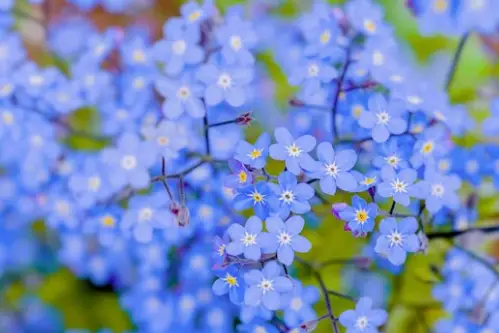Beautiful, fragile forget-me-nots are a charming addition to any garden.
These tiny blue flowers are simple to grow and take care of, making them ideal for beginners who want to brighten up their outside area.
We’ll walk you through the procedures in this article so you can successfully cultivate forget-me-nots from seed.
What to Know About Forget Me Not Flower Before You Plant

- Forget-me-nots are annuals, meaning that they complete their life cycle in one growing season. However, they often self-seed, which means that new plants will often sprout up the following year.
- There are several different varieties of forget-me-nots, including the classic blue flowers as well as white, pink, and purple varieties.
- Forget-me-nots are not just for outdoor gardens. They can also be grown in containers or hanging baskets, making them a great choice for small spaces.
- If you want to attract pollinators to your garden, forget-me-nots are a great choice. Bees and butterflies are attracted to the small, delicate flowers, and will help to pollinate your other garden plants.
- If you live in a warm climate, forget-me-nots may not do well in the heat of the summer. In this case, you may want to consider growing them as a cool season annual, or choosing a different type of plant that is better suited to your climate.
- If you have pets or small children, be aware that forget-me-nots can be toxic if ingested. Keep them out of reach and educate yourself on the signs and symptoms of poisoning if you suspect that someone has consumed the plant.
Choose the Right Location

Forget-me-nots thrive in partial shade, so choose a spot in your garden that receives sunlight for part of the day, but is also shaded for the rest of the time. This will help ensure that the soil remains moist, which is important for the growth of these delicate flowers.
Prepare the Soil
Forget-me-nots prefer soil that is rich in organic matter and well-draining.
If your garden soil is heavy clay, mix in some compost or peat moss to help improve drainage. If your soil is too acidic, add some lime to balance the pH.
Sow the Seeds
Sow the seeds in early spring, after the danger of frost has passed.
Scatter the seeds over the soil surface and lightly press them down.
Don’t bury them too deep, as forget-me-not seeds need light to germinate. Water the seeds gently to keep the soil moist but not waterlogged.
Care for Your Seedlings
Once the seeds have germinated, thin out the seedlings to ensure that they have enough space to grow.
Water them regularly to keep the soil moist but not waterlogged.
If you notice any weeds, remove them as soon as possible, as they can compete with your forget-me-nots for nutrients.
Transplant Your Seedlings
When your seedlings are about 2-3 inches tall, it’s time to transplant them to their final location.
Choose a spot in your garden that receives partial shade and has well-draining soil.
Dig a hole that is slightly larger than the root ball of your seedling and gently place it in the hole.
Backfill the hole with soil and gently firm it down around the base of the plant. Water the plant to settle the soil around the roots.
Maintain Your Forget-Me-Nots

Once your forget-me-nots are established, they require very little care.
Water them regularly during dry spells, but be careful not to overwater them.
Mulching around the plants can help retain moisture in the soil and also prevent weed growth. If you notice any diseased or damaged leaves, remove them promptly to prevent the spread of the disease.
Deadhead Your Forget-Me-Nots
To encourage your forget-me-nots to continue blooming throughout the growing season, it’s a good idea to deadhead them regularly.
Simply remove the spent flowers by snipping off the stems just above the leaves.
This will encourage the plant to produce new flowers, and will also help to prevent the plant from going to seed too quickly.
Protect Your Forget-Me-Nots from Pests and Diseases
Forget-me-nots are relatively pest and disease resistant, but they can sometimes fall prey to slugs, snails, and aphids.
To prevent these pests from damaging your plants, try using organic pest control methods like diatomaceous earth or handpicking them off the leaves.
If you notice any signs of disease, such as yellowing leaves or black spots, remove the affected leaves and dispose of them immediately to prevent the spread of the disease.
Collect Forget-Me-Not Seeds for Next Season
At the end of the growing season, you can collect forget-me-not seeds for planting next year.
Simply wait until the seed heads have turned brown and the flowers have died back, then snip off the seed heads and store them in a cool, dry place.
In the spring, you can sow the seeds just as you did the previous year, and enjoy a new crop of forget-me-nots in your garden.
Share Your Forget-Me-Nots with Friends and Family
Finally, once your forget-me-nots are in full bloom, consider sharing them with friends and family.
You can cut the flowers and place them in a vase to enjoy indoors, or give a potted plant as a gift.
Sharing the beauty of your garden with others is a great way to spread joy and happiness, and connect with others who share your love of gardening.
Conclusion
forget-me-nots are a beautiful and easy-to-grow flower that is perfect for beginners.
With all these simple steps, you can enjoy these charming blue flowers in your garden year after year.
Just remember to choose a spot in partial shade, prepare the soil properly, sow the seeds, care for your seedlings, transplant them to their final location, and maintain your forget-me-nots, and you will have a beautiful garden filled with these lovely flowers in no time!
Reference
Here are some references used in creating this post:
- Burpee Gardening. (n.d.). Forget-Me-Not. https://www.burpee.com/flowers/forget-me-not/
- The Old Farmer’s Almanac. (n.d.). Forget-Me-Not: How to Plant, Grow, and Care for Forget-Me-Nots. https://www.almanac.com/plant/forget-me-nots
- Gardening Know How. (n.d.). How to Grow Forget-Me-Nots.




